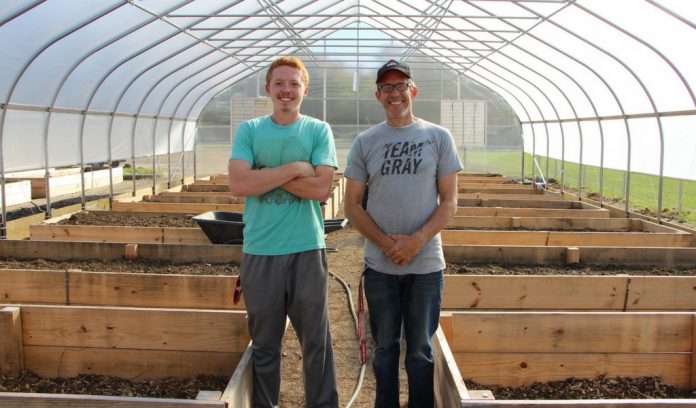
MANSFIELD, Ohio — Ohio State University Associate Professor Kent “Kip” Curtis has a vision of turning a portion of the Mansfield campus into a sustainable urban farm and educational center.
On just one-third of an acre, Curtis, with the help of recent Ohio State Mansfield graduate, Tyler Arter, designed a functional micro-farm on an abandoned parking lot on campus.
During a volunteer day Aug. 19, 30 students from the Environment, Economy, Development, and Sustainability program at Ohio State Columbus joined Curtis and Arter to help construct the farm. The farm features two 30-by-72-foot high tunnels and about 50 raised beds.
Student interns help Curtis and Arter on the school farm, as they work to have their first harvest in late fall. That harvest will include a few fast growing, hardy vegetables, such as radishes and arugula, which will be sold to the campus dining hall.

Local food supply
Curtis envisions the farm being managed by a single farmer, growing as much produce as they can for as long as they can.
The produce will be sold to campus dining halls, local markets they hope to contract with in the future, and some produce will be donated to low-income Mansfield residents through a partnership with North End Community Improvement Collaborative to address food insecurity.
“We know we have a need for a strong local food system in Mansfield,” said Curtis, noting that a majority of the “fresh food” sold in Mansfield is not locally grown. “We want to step in and transfer some of those dollars locally,” said Curtis. He hopes the micro-farm will generate a net income of $20,000 to $30,000 a year.
The micro-farm was made possible through a $100,000 grant from Ohio State University’s President and Provost Council on Sustainability. It is the University’s first investment in a regional campus and fits well with the University’s Discovery Themes Initiative and sustainability goals, explained Curtis.
Education

One of the high tunnels will serve the dual purpose of growing food and becoming an outdoor classroom called the RUSS (Reaching Urban Students with Sustainability) Gardens. Raised beds will surround classroom tables where students can learn about sustainable farming methods while also getting a hands-on learning experience.
While teaching in a low-income elementary school in St. Petersburg, Florida, Curtis found children were more likely to do well in school when they were working in the school garden.
“It gave them a purpose,” said Curtis. “Students engage with the plants in the garden and don’t realize they are learning.” When Curtis came to Ohio State, he wanted to create that same atmosphere on the college level, while also creating a sustainable local food source.

Social need
Arter, a former student of Curtis’, said he was attracted to the project because of it’s potential. “Kip’s enthusiasm is super contagious,” he said.
As a psychology major, planning to start his masters in social work, Arter sees the micro-farm fulfilling a social need in the community. “It’s sad that there is a limited local food supply,” he said.
As the project continues, Curtis said he would like to find ways to incorporate new technology into making the small farm more efficient.
For example, he wants to work with the school’s engineering lab to develop a robot that can do small tasks, such as prepare the raised beds for planting, test the soil and reduce the overall labor of maintaining the micro-farm.
Curtis said he would like to see the Ohio State Mansfield campus become an Extension resource in urban farming, and he hopes the micro-farm will serve as a model for other schools, communities or individuals who are interested in urban farming.
The micro-farm is just one of the many environmental study projects taking place around the Mansfield campus. In December of 2015, OSU-Mansfield teamed up with First Energy to create a Monarch Right of Way under an existing utility right of way on campus.
OSU-Mansfield features 640 acres of vernal pools, pine plantations, legacy forests, prairies and streams that make up the Ecolab — a campus initiative to provide environmental research and community and student engagement on campus.









